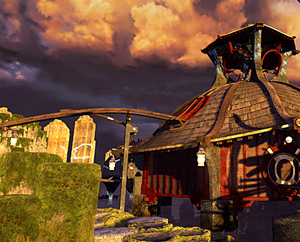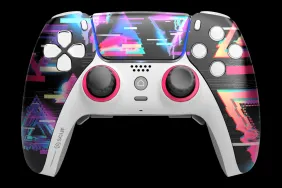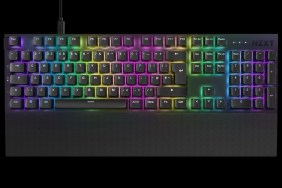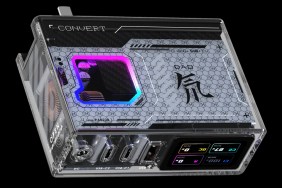Click. Click. Where’s the bang?
I grew up with parents who liked to invite people over and then show slides.
Slides from the kinds of places most parents don’t get to, like the Himalayas,
Nepal, Tibet, Mt. Everest and K2. As a child I had to suffer through these displays
repeatedly, struggling to remain awake for the very pretty, but awfully boring
show. So when Myst first was released, I immediately noticed that it
played like a Macintosh Hyper-Card presentation, I avoided it like the plague
despite its stratospheric popularity.
Now that I’m older, I can sit through my parents’ slides when I come home and
actually be fascinated by them this time. So when the opportunity came to review
Myst 3: Exile, I wondered how much I had changed.
When considering any sequel, especially one that fits into one of the most
successful franchises in electronic entertainment, you have to look at the larger
effects of the series. Exile is not really just Myst, it’s where
the entire “Myst” genre has arrived. What surfaces in looking at Exile
is that what Myst did to regular adventure games has finally happened
to Myst itself.
What’s that mean? While not really Myst’s fault, the flood of sterile,
boring, lifeless slideshow adventure games clamoring at its coattails absorbed
all other types of adventure games, crested and drowned the genre out, save
for a few stalwarts such as Grim Fandango or
the newer Monkey Island games. The
tide has turned, and now the slideshow adventure games have receded, and Myst
3 is one of the few.
In that situation, Myst’s creators are surely hoping that their newest
entry will revitalize their favorite genre. And while it’s a good try, it just
can’t do what the original did so many years ago.
To give Myst 3 its due credit, it is a beautiful slideshow. While I
wont bother explaining the typically abstract plot, the abstract settings are
eerie and evocative and strange and brilliantly rendered. There is plenty of
eye candy to be found throughout the game, all of it viewable through a panoramic
engine that allows you to view your surroundings in a smooth 360 degrees of
vision just by turning the mouse. There are some clever uses of this, such as
localized sounds that you must face to begin an event. There is also support
for 3D hardware to generate some appealing effects. Sound and music are likewise
handled exceptionally well, with great production values all around.
While the universal mark of quality helps make things immersive, and while
the graphical talent on display is certainly impressive, there is a mild quandary
that prevents a person from truly wanting to simply gaze at the scenery. We
look at static artistic images because there is meaning and significance conveyed
in them; they have life. In games, artwork isn’t really like art in a museum
– it exists to set the mood and provide some pretty scenery. So while Myst
3 is gorgeous, there is nothing fulfilling within its graphical lushness
and therefore much more of the experience falls on the shoulders of the puzzles
that make up gameplay.
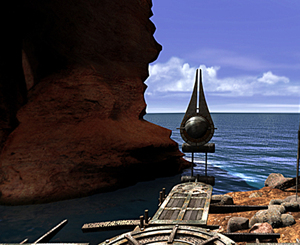 And in
And in
all fairness, the puzzles are good. Unlike Riven,
which was akin to an IQ test from hell, Myst 3 is reasonably approachable.
Of course, the puzzles play with the same sort of strange machines and books
and levers and knobs and switches and thingamabobs just like usual. However,
unlike some of the puzzles in the earlier Myst games, most puzzles in
Exile are contained within their own smallish area meaning that there
is far less running (clicking?) back and forth between areas, which is a definite
plus. The puzzles are still cerebral enough that non-gamers can justify playing
the game without feeling guilty and real gamers can be challenged, it all depends
if you enjoy fiddling with things.
But everything I’ve just said could also be applied to Myst itself.
So what is different about Exile? Aside from the slightly new setting (it’s
not the same island), new plot, and new technology, there is very little new
in Exile. It feels much like the same experience as its predecessors
except that where Myst broke new ground, Myst 3 is strictly by
the numbers. If you enjoy the Myst games, then Exile should be
plenty fun, but if you never liked them then Myst 3 is not likely to
convert you.
Furthermore, Exile is not without its own unique faults. King among
these are some extremely annoying bugs. For example, every time you start the
game, Exile needs to have the install disc in your CD-ROM drive, but
when playing the game, it needs one of the 3 play discs. This means that every
time you play Exile there is some really bothersome disc swapping when
none should actually be required.
Perhaps this is a strange moment in gaming, a crisis of identity. Gaming has
become such a large industry that it is being overcrowded with imitators and
strangled by unreasonable bottom-line business demands. Myst was a game
that changed gaming – perhaps not for better – but it did change it. Conversely,
Exile is just an exercise that lacks the energy to make anyone ebullient.
But that isn’t to say it’s not damn pretty.

-
Looks Good
-
Sound Good
-
More Reasonable Gameplay
-
Still Just
-
Empty and Buggy
